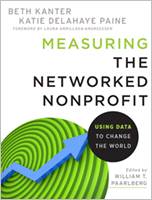 Beth Kanter and Katie Delahaye Paine describe their new book, Measuring the Networked Nonprofit, as a meal in three courses. They set the table with an introduction to measurement and the basic practices of networked non-profits. They follow it with a healthy portion of measurement techniques. And for dessert they offer some advanced practices. It’s a good meal at that, and for many of us there’s a reason why we come running to the table when we hear who our hosts are.
Beth Kanter and Katie Delahaye Paine describe their new book, Measuring the Networked Nonprofit, as a meal in three courses. They set the table with an introduction to measurement and the basic practices of networked non-profits. They follow it with a healthy portion of measurement techniques. And for dessert they offer some advanced practices. It’s a good meal at that, and for many of us there’s a reason why we come running to the table when we hear who our hosts are.
Kanter is well established as an international leader in non-profits’ use of social media. Her first book, The Networked Nonprofit, introduced non-profits to a new way of thinking and operating in a connected world. Her blog continues to be a go-to source for those in the field, particularly concerning social media practice for non-profits. Full disclosure: she is a visiting scholar at the Packard Foundation and she spends some of her time coaching and training many of the non-profits we fund. Now she has teamed up with Paine, a leading consultant on measurement and accountability, to present a guide to collecting data on communications and social media results, and how to use that data to learn and improve our work.
The ideas in their book are grounded in, and derived from, practice. Kanter ran a measurement peer-learning group with Packard Foundation grantees and created a wikispace for sharing information. Several themes permeate the book, including a focus that social change is the true goal, that measurement ultimately helps non-profits listen and engage better, and that data is best collected to inform decisions and planning; data without insight is far less useful.
The authors are not suggesting we be ‘data driven’ but rather ‘data informed’ – building in assessment, learning and revision in order to use measurement constantly to improve. This is the same philosophy we espouse in our monitoring and evaluation work at the Packard Foundation. Measurement, they note, is a powerful tool, providing feedback, saving time, and stimulating ideas for next steps. In short, it helps you work smarter. And Kanter and Paine show that measurement is valuable at every level – it’s simply part of good governance, they note – and that there can be incremental success for non-profits moving towards a networked model.
So what are some of their basic steps to good measurement? Define your goals, your audience, benchmarks, metrics, time and costs, along with your data collection tools; and then start collecting and analysing.
But Measuring the Network Nonprofit is an entertaining, human book – not just for people already deeply in love with the idea of measurement. And Kanter and Paine want to be sure that we don’t simply confuse results with activity.
Their book is filled with examples from non-profits and their everyday work, with Kanter’s time guiding Packard grantees serving, in some cases, as research for the book. We learn, for example, how MomsRising, a grassroots organization mobilizing around issues facing women, mothers and families, has a weekly Monday morning meeting to review metrics and tell ‘campfire stories with the data’. No matter what the activity, they examine the metrics to see if it supports their goals of ‘growing the movement and winning legislative policy changes’. They look beyond just the numbers, for stories and context. They look for patterns and insights that they can use to improve their tactics.
Measuring the Networked Nonprofit is a practical guide for non-profits, and it essentially begs you to roll up your sleeves as you read through it actively rather than passively. Each chapter ends with reflection questions and the book concludes with a social media checklist, along with a checklist for monitoring services. But do not be confused. These are not isolated tactics. Kanter and Paine are all about impact.
‘Non-profits work on a multitude of different issues and programs, but they share a single passion: to make the world a better place,’ they write. ‘For non-profits, social change is the only bottom line … measurement is how they know they are doing it.’
Carol Larson is president and CEO of the David & Lucile Packard Foundation.
To order
http://measurenetworkednonprofit.org
Measuring the Networked Nonprofit
Beth Kanter and Katie Delahaye Paine Jossey Bass $34.95/£23.99
ISBN 978-1118137604





Comments (0)